
28 minute read
ARTS & CULTURE
ARTS & CULTURE ARTS & CULTURE

Advertisement
Bootlegger George Remus is said to have inspired The Great Gatsby.
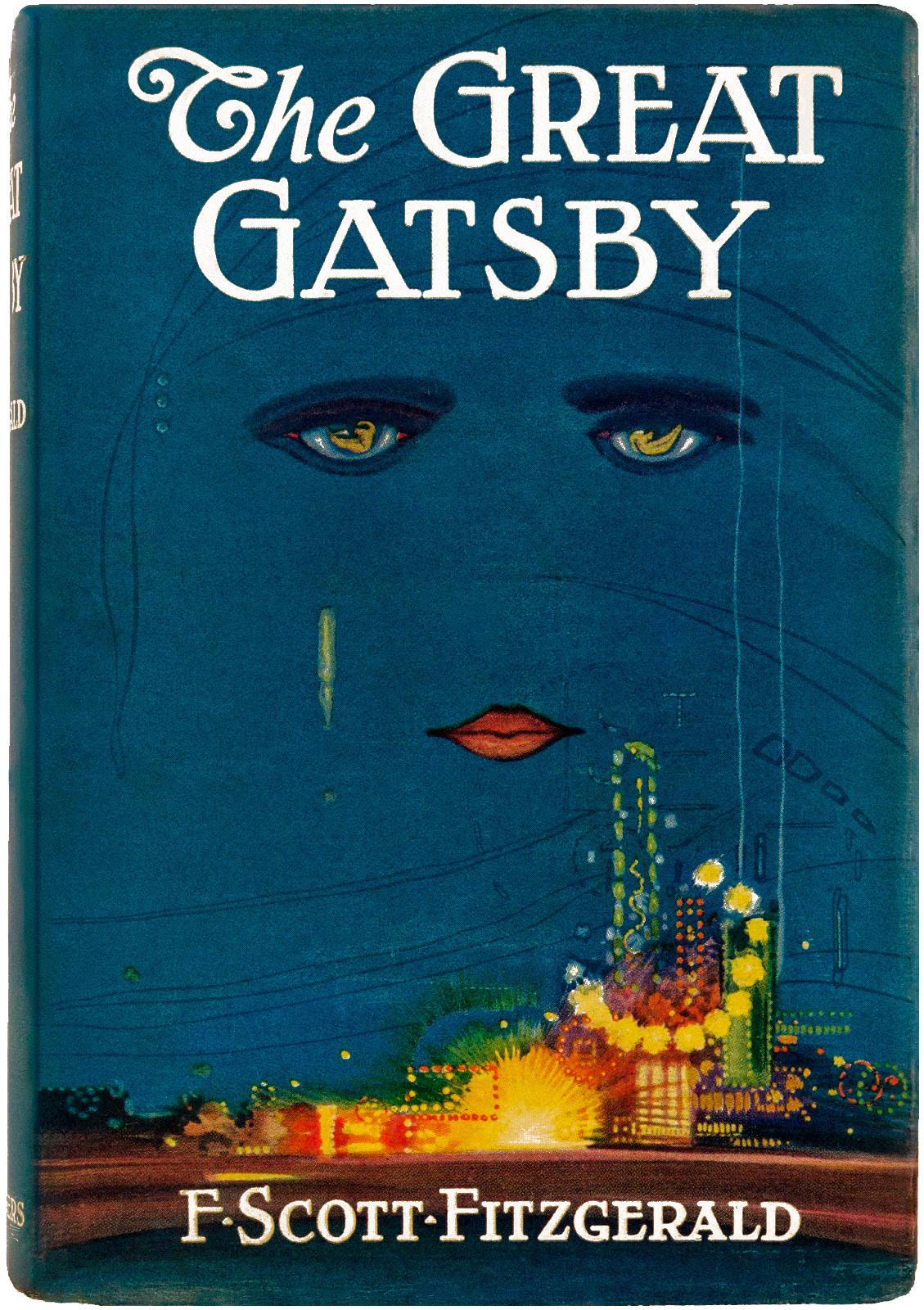
PHOTO: PUBLIC DOMAIN
The Carnegie Brings Cincinnati Bootlegger George Remus’ Story to Life in Covington The Carnegie Brings Cincinnati Bootlegger George Remus’ Story to Life in Covington Was Remus’ lavish life the inspiration for e Great Gatsby?

Maggie Perrino is The Carnegie’s theater director.

PHOTO: PROVIDED BY THE CARNEGIE Maggie Perrino is The Carnegie’s theater director.
PHOTO: PROVIDED BY THE CARNEGIE
The outrageous life of bootlegger George Remus will be recounted onstage in August at e Carnegie in Covington. e Carnegie’s theater director Maggie Perrino is staging George Remus: A New Musical, one of three shows presented in a summer repertory season that includes Stephen Sondheim’s Into the Woods and Jonathan Larson’s Rent.
Perrino tells CityBeat that she met composing team Mark Friedman and Janet Yates Vogt when she directed the November 2017 production of their musical Tenderly: e Rosemary Clooney Musical at e Carnegie.
“It was a really merry crew on that show,” Perrino says. “ ey mentioned they were working with local playwright Joe McDonough on a show about George Remus.” She adds that she o ered to give it a workshop at e Carnegie, and they agreed.
Perrino’s plan was to see how it worked with a reading in 2020; of course, the worldwide pandemic made that impossible. But Perrino’s inventive management of theater o erings during 2021 a orded another possibility.
“We did a mini-season of short performances at the new Covington Plaza on the Ohio River shore,” Perrino says. “Mark, Janet and Joe liked the idea of a staged reading, and the location by the Suspension Bridge made sense, since Remus’s bootlegging career was based in Covington and Cincinnati, both visible from the plaza.”
With a dozen performers, Vogt on piano with a drummer, and a bit of choreography, the reading happened twice last August.
“We had surprisingly good crowds — 450 tickets were sold for each night. People seemed interested in Remus’s story, and we were able to see more of what worked and what needed more work,” she says. eir re nements continued for another year — the show has had “some 20-odd drafts,” according to Perrino, and now it’s ready for a full- edged performance this summer.
Perrino didn’t know much about Remus before she began work on the show. She says she learned that he died in 1952 at age 74 in a modest home just a few blocks from e Carnegie. at was a signi cant comedown from his heyday in the 1920s when his megamansion “ e Marble Palace,” located at 8th and Hermosa in Price Hill, was the scene for legendary parties, in part due to its $100,000 indoor swimming pool.
Remus showered his prestigious guests with gifts, including diamond stickpins and brand-new cars, according to the Price Hill Historical Society. Although Remus was not a drinker, his expansive Prohibition-era bootlegging empire a orded him a lavish lifestyle.
According to various biographies and accounts, his life was full of ups and downs, coming to the United States from Germany as a child in 1882 and settling in Chicago. Remus earned a pharmacy degree in 1897 but became a criminal defense attorney by 1902, making his name by defending a man in a sensational murder case. By 1920 Remus earned $500,000 annually with high-rolling clients.
When Prohibition was imposed in 1920, Remus’ legal knowledge paved the way to an illicit career producing and distributing alcohol under the guise of medicinal purposes. He moved to Cincinnati to be closer to whiskey manufacturers and built up a business with more than 3,000 employees. Remus became a multi-millionaire with a reputation as “ e King of the Bootleggers, per a post from online project Immigrant Entrepreneurship: German-American Business Biographies, 1720 to the Present.
Remus’ notorious career eventually landed him in prison. While he was incarcerated, his wife Imogene had an a air with an undercover prohibition agent, and they pillaged his fortune. Following Remus’s release, Imogene reportedly was on her way to the courthouse to divorce him when he gunned her down in Eden Park near its Victorian gazebo. Remus was acquitted of murder under a temporary insanity defense, according to a post on the Cincinnati Public Library’s website.
Remus’ history covers a lot of ground. But Perrino says Friedman and Vogt’s score for George Remus: A New Musical appropriately matches the era.
“It’s in the style of Golden Age theater with some lovely ballads and wistful romantic songs. It also has a splash of Jazz-Age, post-Ragtime numbers,” Perrino says.
She calls the show a “musical drama” about the astounding events of Remus’s life, adding “It’s a sensational story told as realistically as possible.” e Carnegie’s content advisory for the show warns of “adult themes and language” and adds that it is “not suitable for young children.”
“Al Capone is in the show, and he certainly uses a bit of bad language,” Perrino says.
Mike Sherman, an actor and theater teacher at Walnut Hills High School, will play Remus, returning to the colorful role he lled in last summer’s workshop. He’s joined by Kate Mock Elliott, another returning performer from 2021, in the key role of Mabel Walker Willebrandt, an assistant U.S.
The outrageous life of bootlegger George Remus will be recounted onstage in August at e attorney general in charge of Prohibition prosecution who doggedly pursued Carnegie in Covington. e Carnegie’s Remus’s illegal activity. theater director Maggie Perrino is stag- Kyle D. Taylor plays the tale’s narrator ing George Remus: A New Musical, one as F. Scott Fitzgerald. As e Carnegie of three shows presented in a summer states in the synopsis of the show on its repertory season that includes Stephen website, it’s commonly believed that Sondheim’s Into the Woods and Jona- Remus was an inspiration for Fitzger-than Larson’s Rent. ald’s e Great Gatsby, the 1925 novel
Perrino tells CityBeat that she met about a mysterious millionaire with composing team Mark Friedman and shady business connections. Perrino Janet Yates Vogt when she directed the says the narrator helps the audience November 2017 production of their follow Remus’s timeline, up to his death musical Tenderly: e Rosemary Cloo- in the 1950s. ney Musical at e Carnegie. Perrino’s summer season with
“It was a really merry crew on that shows in rotating repertory employs a show,” Perrino says. “ ey mentioned single set that can be tailored for each they were working with local play- production.wright Joe McDonough on a show “ e set can easily be Remus’s ware-about George Remus.” She adds that house,” Perrino says. “We’re creating she o ered to give it a workshop at e his mansion using great photography Carnegie, and they agreed. from the era, and we use many other
Perrino’s plan was to see how it projections to indicate time and place, worked with a reading in 2020; of for example as he moves from Chicago course, the worldwide pandemic made to Cincinnati in 1917 and to Covington that impossible. But Perrino’s inventive in the 1950s.” management of theater o erings during Her recon guration of the season has 2021 a orded another possibility. reduced costs. It’s been a useful experi-
“We did a mini-season of short per- ment, she says. formances at the new Covington Plaza “We’re learning as we go,” she says. on the Ohio River shore,” Perrino says. “Subscriptions have been strong. You “Mark, Janet and Joe liked the idea of a can still buy one in August and see all staged reading, and the location by the three shows.” Suspension Bridge made sense, since Perrino’s multi-show approach Remus’s bootlegging career was based has o ered diverse opportunities for in Covington and Cincinnati, both vis- local theater performers and design-ible from the plaza.” ers training at University of Cincin-
With a dozen performers, Vogt on nati’s College-Conservatory of Music, piano with a drummer, and a bit of cho- Northern Kentucky University and reography, the reading happened twice Xavier University. Lighting designers last August. from CCM are providing sophisticated
“We had surprisingly good crowds illumination for each production. — 450 tickets were sold for each night. People seemed interested in Remus’s story, and we were able to see more of what worked and what needed more work,” she says. eir re nements continued for another year — the show has had “some 20-odd drafts,” according to Perrino, and now it’s ready for a full- edged performance this summer. Perrino didn’t know much about Remus before she began work on the show. She says she learned that he died in 1952 at age 74 in a modest home just a few blocks from e Carnegie. at was a signi cant comedown from his heyday in the 1920s when his megamansion “ e Marble Palace,” located at 8th and Hermosa in Price Hill, was the scene for legendary parties, in part due to its $100,000 indoor swimming pool. Remus showered his prestigious guests with gifts, including diamond stickpins and brand-new cars, according to the Price Hill Historical Society. Although Remus was not a drinker, his expansive Prohibition-era bootlegging empire a orded him a lavish lifestyle. According to various biographies and accounts, his life was full of ups and downs, coming to the United States from Germany as a child in 1882 and settling in Chicago. Remus earned a pharmacy degree in 1897 but became a criminal defense attorney by 1902, making his name by defending a man in a sensational murder case. By 1920 Remus earned $500,000 annually with high-rolling clients. When Prohibition was imposed in 1920, Remus’ legal knowledge paved the way to an illicit career producing and distributing alcohol under the guise of medicinal purposes. He moved to Cincinnati to be closer to whiskey manufacturers and built up a business with more than 3,000 employees. Remus became a multi-millionaire with a reputation as “ e King of the Bootleggers, per a post from online project Immigrant Entrepreneurship: German-American Business Biographies, 1720 to the Present. Remus’ notorious career eventually landed him in prison. While he was incarcerated, his wife Imogene had an a air with an undercover prohibition agent, and they pillaged his fortune. Following Remus’s release, Imogene reportedly was on her way to the courthouse to divorce him when he gunned her down in Eden Park near its Victorian gazebo. Remus was acquitted of murder under a temporary insanity defense, according to a post on the Cincinnati Public Library’s website. Remus’ history covers a lot of ground. But Perrino says Friedman and Vogt’s score for George Remus: A New Musical appropriately matches the era. “It’s in the style of Golden Age theater with some lovely ballads and wistful romantic songs. It also has a splash of Jazz-Age, post-Ragtime numbers,” Perrino says. She calls the show a “musical drama” about the astounding events of Remus’s life, adding “It’s a sensational story told as realistically as possible.” e Carnegie’s content advisory for the show warns of “adult themes and language” and adds that it is “not suitable for young children.” “Al Capone is in the show, and he certainly uses a bit of bad language,” Perrino says. Mike Sherman, an actor and theater teacher at Walnut Hills High School, will play Remus, returning to the colorful role he lled in last summer’s workshop. He’s joined by Kate Mock Elliott, another returning performer from 2021, in the key role of Mabel Walker Willebrandt, an assistant U.S. attorney general in charge of Prohibition prosecution who doggedly pursued Remus’s illegal activity. Kyle D. Taylor plays the tale’s narrator as F. Scott Fitzgerald. As e Carnegie states in the synopsis of the show on its website, it’s commonly believed that Remus was an inspiration for Fitzgerald’s e Great Gatsby, the 1925 novel about a mysterious millionaire with shady business connections. Perrino says the narrator helps the audience follow Remus’s timeline, up to his death in the 1950s. Perrino’s summer season with shows in rotating repertory employs a single set that can be tailored for each production. “ e set can easily be Remus’s warehouse,” Perrino says. “We’re creating his mansion using great photography from the era, and we use many other projections to indicate time and place, for example as he moves from Chicago to Cincinnati in 1917 and to Covington in the 1950s.” Her recon guration of the season has reduced costs. It’s been a useful experiment, she says. “We’re learning as we go,” she says. “Subscriptions have been strong. You can still buy one in August and see all three shows.” Perrino’s multi-show approach has o ered diverse opportunities for local theater performers and designers training at University of Cincinnati’s College-Conservatory of Music, Northern Kentucky University and Xavier University. Lighting designers from CCM are providing sophisticated illumination for each production.
Mike Sherman portrays George Remus.
PHOTO: MIKKI SCHAFFNER PHOTOGRAPHY Mike Sherman portrays George Remus.
PHOTO: MIKKI SCHAFFNER PHOTOGRAPHY
George Remus: A New Musical will George Remus: A New Musical will run Aug. 13-28 at e Carnegie, 1028 Scott run Aug. 13-28 at e Carnegie, 1028 Scott Blvd., Covington. Info: thecarnegie.com. Blvd., Covington. Info: thecarnegie.com.
CULTURE Milford’s PAUSE OFF Artist Collective Is Ready to Press Play BY KATIE GRIFFITH
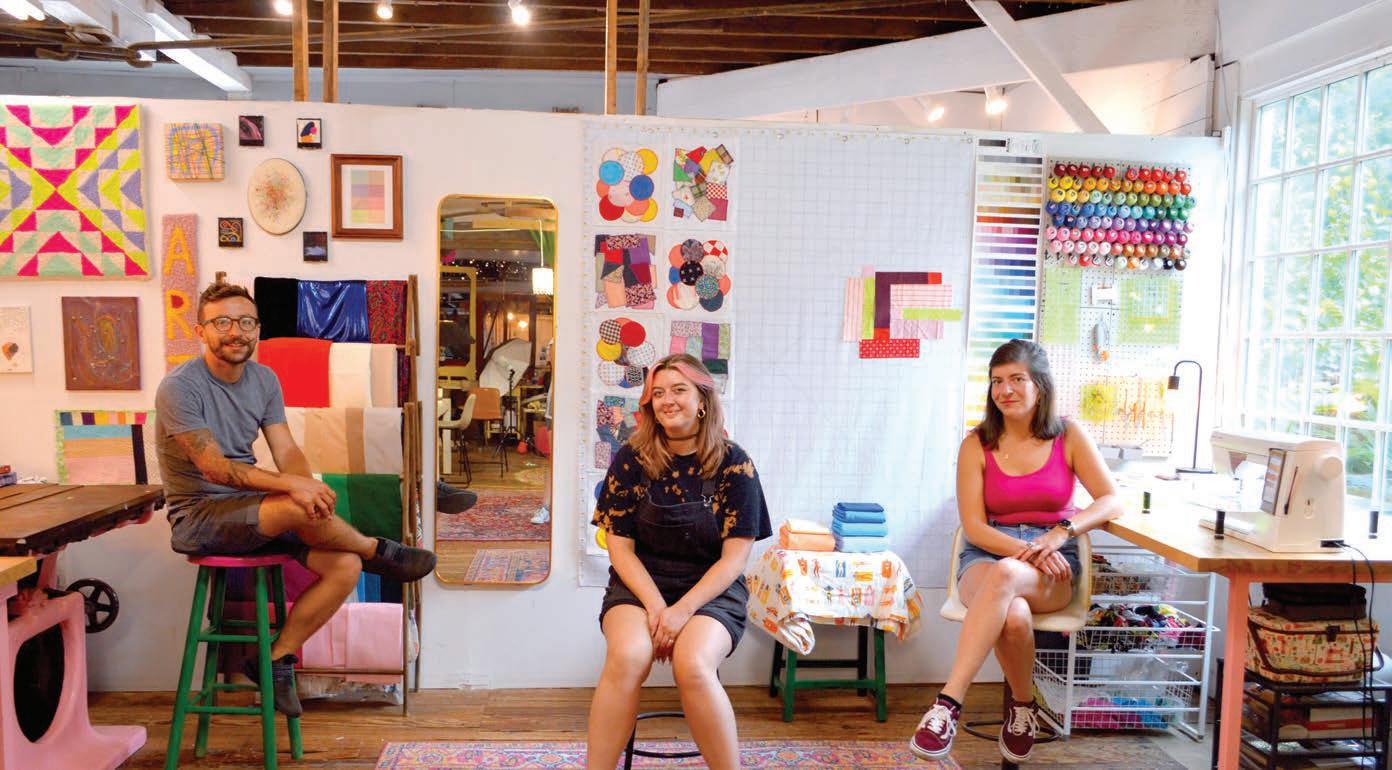
(L-R) Chris Clements, Lindsey Clements and Noelle Dumont recently launched PAUSE OFF.
PHOTO: KATIE GRIFFITH
Behind the colorful sliding doors of a historic barn on Wooster Pike in Milford, an explosion of contemporary art is thriving. e building’s interior walls are a conglomerate of wood, perfuming the space with scents of cedar and sandalwood. e Little Miami River rushes through the backyard, adding even more ambiance to the space. ese cozy attributes are now home to the new artist collective PAUSE OFF, owned by three Milford natives who curated the vibrant space and installed ve working studios plus a gallery. e collective’s name refers to hitting “play,” as in lifting a pause. As three friends from high school, PAUSE OFF’s owners materialized their dream of creating space for artists and for people to experience and make art. Husband and wife Lindsey and Chris Clements graduated from e Art Academy of Cincinnati with sculpting degrees, while Noelle Dumont is self-taught. e trio worked with collective members Sam Zachary and Corey Schultz to bring the space to life and promote a creative, functional gallery and studios. Together, the group represents artistic styles like sculpting, painting, pottery, quilting, writing and photography.
PAUSE OFF opened to the public in May and is gearing up for a second gallery exhibition to open in August.
“If you’re not paused, you’re playing. It’s an active place,” Lindsey Clements says of the meaning behind the name of the collective. “We’ve always dreamed of some sort of collective. We all have a shared interest in continuing to practice and make work all the time and in one building. We’ve rented studios before – lots of places – and so we’ve always liked the idea of working with multiple artists in one building, but we never had the space or knew where to nd it.”
It turns out, the space they’d hoped to discover has been a working part of their community since the 1900s. e barn housing PAUSE OFF served Milford as e Reihle Planing Company from 1930 until the mid ’60s, according to the Greater Milford Area Historical Society. Before that, it was a stable. e structure went on to house a local cabinet maker and woodworker.
Carolyn Sue Johnston bought the barn in 2010 with the hopes of preserving it and giving it an artistic purpose. After she passed in 2018, the building went to her son, Adam Smith. at’s where Chris Clements and the vision for PAUSE OFF came in.
“We felt that [Johnston] would have been so happy after the woodworker moved out that an artistic group moved in there,” says Darryl Donovan, barn landlord of four years and Johntson family friend. “She was very much a person that believed in artistic expression.”
“Chris was the rst person I met when I moved to Milford, and he showed up one day and was talking to Adam about renting it,” Donovan continues. “And so Adam and I talked, and we both agreed that they were the perfect t. Chris had this exuberance about what they wanted to do with it, and when they moved in, they did nothing but improve it.” e PAUSE OFF team has been renting the building for about two years now, but they’ve spent most of that time cleaning and renovating the space. ey’ve built a few walls and put a lot of e ort into clearing scrap wood, sawdust and rogue nails. e custom studio spaces are works of art themselves, each with its own personality and colorful air. e open oor plan allows visitors to roam freely, but the di erent personalities of the artists are apparent when entering a new space. Shultz has cultivated a cozy corner of the barn – a tidy area with a typewriter and poetry on the walls. Dumont’s studio is adorned with organized fabric and yarn, some quilt plans above her desk and a collage of polaroids cascading from the ceiling.
e collective makes use of leftover wood planing machines that are too heavy to move; Dumont especially enjoys the one closest to her workspace, as it doubles perfectly as an iron for her fabric.
“I think it’s just like with any old building – all the character and all the little bits of who’s walked here and why things are the way they are,” Chris Clements says. “It’s the only barn left in Old Milford. I think when you walk in, you feed o of all the things that have happened in here.”
“It’s always been a functional building; it had a purpose of making things,” he continues. “Like, when it was a woodshop, it was planing boards for houses. It was being functionally important to the community. I think now [that] we are making something, we are giving the community art, we are feeding it in a di erent way.”
PAUSE OFF opened its doors to the public on May 27 with the debut exhibit Re lls, which honors the ve members’ shared professional experience in the restaurant industry. Re lls is still on view for a limited time.
Among the installations and textile art in the Re lls exhibit, Lindsey Clement’s sculptures are the brightest of the bunch, literally. A de ated ball masked with re ective disco tiles and draped with neon-pink chains titled “Nothing Good Happens After 10 p.m.”hangs next to a one-of-a-kind pair of earrings called “Narry’s Nightmare Nails. ” For that, the artist joined acrylic nails to create three-foot long, amboyant earrings. e collective members already are well-known in Milford, having managed and served at local establishments like e Governor and 20 Brix.
“Re lls was a play on our roles in our jobs,” Chris Clements says. “And also like, here’s a re ll, here’s something to refresh you. But it wasn’t a typical gallery show. We didn’t put up prices or anything like that. We really just wanted people to experience it. It was really just a taste of everybody’s aesthetic.”
Even though the collective didn’t aim to create sales, the outpouring of community support led to multiple transactions and private donations. Karen Dorn, a regular customer at e Governor — where Chris and Dumont work — attended the opening and bought a painting from Lindsey.
“I feel like it’s a model that we don’t see very often here. I have some experience with the arts community here in Cincinnati. Pendelton is kind of a good example of a studio-slash-gallery workspace in Cincinnati, but when you get outside of the urban core, you are not seeing much of that,” Dorn says. “I think the concept lls a gap in the city but especially outside of downtown proper. Community-wise, it was incredible to me when we went out for the opening to see the number of people from the Milford community and elsewhere.”
PAUSE OFF is part of Milford’s renaissance, with Main Street just around the corner seeing signi cant growth over the past few years thanks to the addition of Little Miami Brewing Company, various restaurants and shops and the 2019 creation of a Designated Outdoor Refreshment Area (DORA).
“Milford is now becoming cool. It’s crazy,” Chris Clements says. “I’ve waited my whole life for it. You have nature everywhere, the river, this little hometown Main Street with cute buildings. e community is really great, and if there’s more places like this, we get to keep those talented people here. If you would have seen Milford 10 years ago, the transformation is crazy.” e collective is preparing for its upcoming exhibition Body, an allfemale-identifying show that’s scheduled to open Aug. 19. Chris Clements says it is especially important to the collective to promote women’s points of view, with reproductive health and rights taking permanent spots in the current news cycle. PAUSE OFF is dedicated to hosting shows monthly, with an exception in winter.
PAUSE OFF renovations will be completed in the coming year, and the space eventually will function as an art center that o ers classes, summer camps and space for individual artists.
PAUSE OFF. An Artist Collective
is located at 24 Wooster Pike, Milford. For information about the artist collective and upcoming exhibitions, visit pauseo anartistcollective.com.

ONSTAGE ONSTAGE Cincinnati Chamber Orchestra’s Summermusik Festival is Cincinnati Chamber Orchestra’s Summermusik Festival is Bringing Award-Winning Compositions to the Queen City
BY ANNE ARENSTEIN
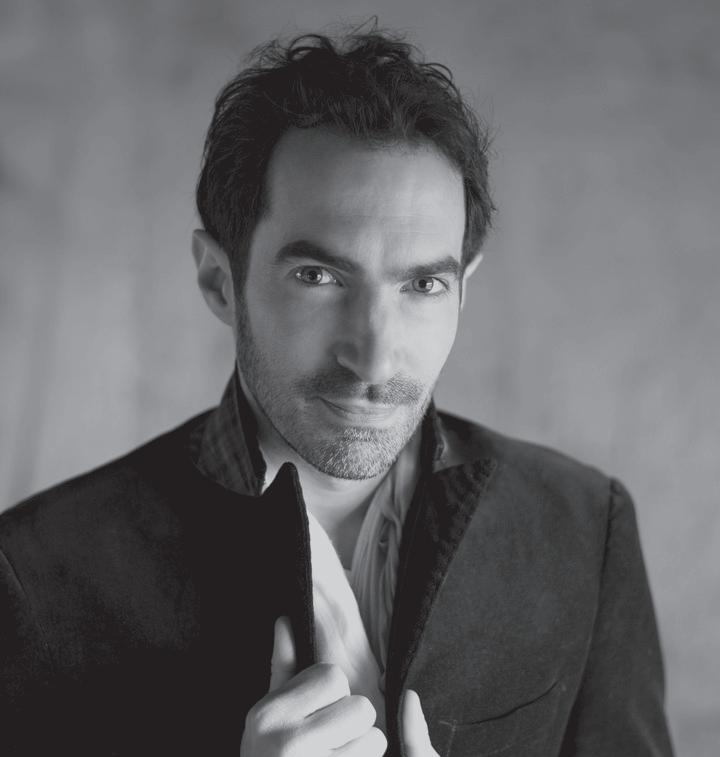
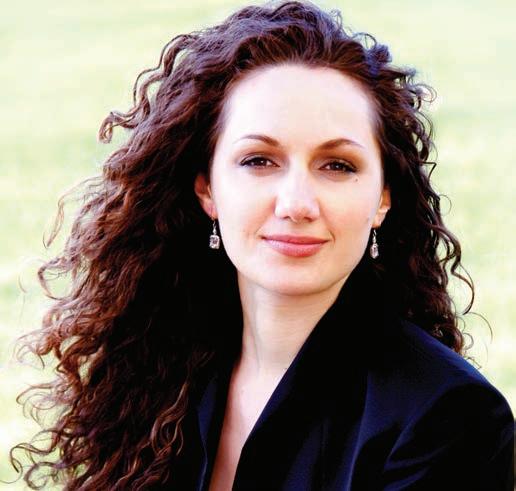

Cincinnati Chamber Orchestra’s Summermusik festival is back to liven August’s dog days with a packed schedule of events. After a canceled 2020 season and abbreviated season performed outdoors in 2021, CCO’s music director Eckart Preu shares every artistic director’s eagerness to return to normal. “I wanted a grand return to our indoor season,” Preu tells CityBeat, speaking from his home in New York. “Some of the pieces scheduled are familiar, arranged for chamber orchestra or completely re-imagined. And we’re also working with exciting new venues for our afternoon series and pub crawls.” Beyond classic works by Gustav Mahler, Hector Berlioz, Claude Debussy, and Pyotr Ilyich Tchaikovsky, Preu has selected music by women, Asian, Latino and Black composers, extending over four weekends. With just one exception, every piece is a CCO premiere. e season is a sampler of world music ranging from sensuous tango, water percussion and Bossa Nova to a battle of the bands. Each weekend series includes a full orchestral concert at the School for Creative and Performing Arts, a Sunday afternoon concert and evening pub crawls, with many events already sold out. e sounds of Argentina and Peru open the season on Aug. 6, featuring Grammy Award-winning musician and composer Héctor del Curto who performs Astor Piazzolo’s vibrant concerto for bandoneon, Aconcagua. Tony winner Fernanda Ghi and her partner Silvio Grand take the stage, dancing to three tangos by Piazzola. On Aug. 7, Del Curto, Ghi and Grand join a quintet of CCO musicians at Mount Notre Dame Academy in Park Hills, Kentucky, for tango in a more intimate setting. Harpist Ina Zdorovetchi headlines a weekend of music on Aug. 13 and 14 that pushes the harp and the orchestra out of the celestial spheres. She performs Arturo Marquez’s Concerto for Harp (Mascaras) and Gyorgy Liegeti’s Concerto Romanesc. “ is is not your average harp concerto,” Preu says. “Mascaras is very di cult and calls for a virtuoso, which Ina is. Audiences are amazed at what the harp and this harpist can do.” at may not be the only music to amaze audiences. e CCO will perform Berlioz’s classic drug dream Symphonie Fantastique that Preu calls a funky reimagination arranged by C incinnati Chamber Orchestra’s Summermusik festival is back to liven August’s dog days with a packed schedule of events. After a canceled 2020 season and abbreviated season performed outdoors in 2021, CCO’s music director Eckart Preu shares every artistic director’s eagerness to return to normal. “I wanted a grand return to our indoor season,” Preu tells CityBeat, speaking from his home in New York. “Some of the pieces scheduled are familiar, arranged for chamber orchestra or completely re-imagined. And we’re also working with exciting new venues for our afternoon series and pub crawls.” Beyond classic works by Gustav Mahler, Hector Berlioz, Claude Debussy, and Pyotr Ilyich Tchaikovsky, Preu has selected music by women, Asian, Latino and Black composers, extending over four weekends. With just one exception, every piece is a CCO premiere. e season is a sampler of world music ranging from sensuous tango, water percussion and Bossa Nova to a battle of the bands. Each weekend series includes a full orchestral concert at the School for Creative and Performing Arts, a Sunday afternoon concert and evening pub crawls, with many events already sold out. e sounds of Argentina and Peru open the season on Aug. 6, featuring Grammy Award-winning musician and composer Héctor del Curto who performs Astor Piazzolo’s vibrant concerto for bandoneon, Aconcagua. Tony winner Fernanda Ghi and her partner Silvio Grand take the stage, dancing to three tangos by Piazzola. On Aug. 7, Del Curto, Ghi and Grand join a quintet of CCO musicians at Mount Notre Dame Academy in Park Hills, Kentucky, for tango in a more intimate setting. Harpist Ina Zdorovetchi headlines a weekend of music on Aug. 13 and 14 that pushes the harp and the orchestra out of the celestial spheres. She performs Arturo Marquez’s Concerto for Harp (Mascaras) and Gyorgy Liegeti’s Concerto Romanesc. “ is is not your average harp concerto,” Preu says. “Mascaras is very di cult and calls for a virtuoso, which Ina is. Audiences are amazed at what the harp and this harpist can do.” at may not be the only music to amaze audiences. e CCO will perform Berlioz’s classic drug dream Symphonie Fantastique that Preu calls a funky reimagination arranged by French composer Arthur Lavandier on French composer Arthur Lavandier on


Fernanda Ghi dances to three tangos during Summermusik.
PHOTO: PROVIDED BY CINCINNATI CHAMBER ORCHESTRA Fernanda Ghi dances to three tangos during Summermusik.
PHOTO: PROVIDED BY CINCINNATI CHAMBER ORCHESTRA
Percussionist Yuri Yamashita headlines one of CCO’s pub crawls.
PHOTO: PROVIDED BY CINCINNATI CHAMBER ORCHESTRA Percussionist Yuri Yamashita headlines one of CCO’s pub crawls. A performance by Hector Del Curto will open the festival.
PHOTO: SERGIO R. REYES A performance by Hector Del Curto will open the festival.
PHOTO: SERGIO R. REYES
Harpist Ina Zdorovetchi headlines a weekend of music.
PHOTO:PROVIDED BY CINCINNATI CHAMBER ORCHESTRA Harpist Ina Zdorovetchi headlines a weekend of music.
PHOTO:PROVIDED BY CINCINNATI CHAMBER ORCHESTRA
Silvio Grand is Ghi’s tango partner.
PHOTO: PROVIDED BY CINCINNATI CHAMBER ORCHESTRA Silvio Grand is Ghi’s tango partner.
Acclaimed pianist Vijay Venkatesh will perform Clara Schumann’s Piano Concerto.
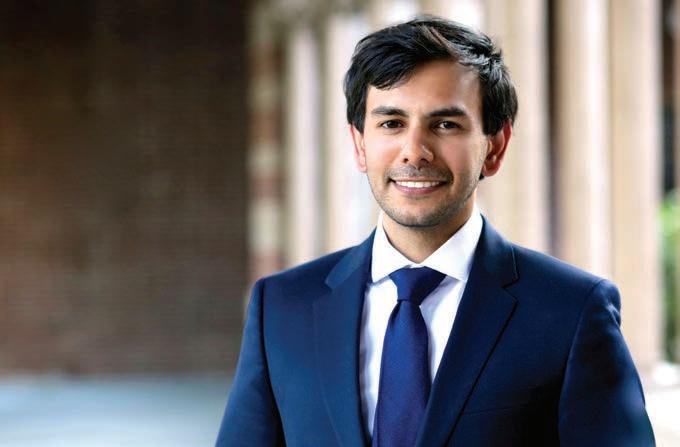
PHOTO: PROVIDED BY CINCINNATI CHAMBER ORCHESTRA Acclaimed pianist Vijay Venkatesh will perform Clara Schumann’s Piano Concerto.
PHOTO: PROVIDED BY CINCINNATI CHAMBER ORCHESTRA
Aug. 13. e show will take place at the School for Creative & Performing Arts’ Corbett eatre downtown.
“With a smaller orchestra, the sound world opens up and you can hear more of the orchestral textures,” Preu explains. “Lavandier includes a synthesizer, an electric guitar, an amateur wind band joining the orchestra onstage and an alpine horn.”
“ e electric guitar solo ts in beautifully, as does the synthesizer. We’re bringing in a [University of Cincinnati College-Conservatory of Music] alum living in Chicago to do the alpine horn solo. It’s complicated but a lot of fun,” he adds.
Harp wizardry continues during “A Little Afternoon Musik” series with selections inspired by works in the CAM’s collection. e Power of the Muse, performed at the School for Creative & Performing Arts’ Corbett eatre on Aug. 20, explores music written and inspired by women. “ ere are such powerful stories associated with the muses we’re featuring, and it’s important to share these stories,” Preu says.
“Lili Boulanger is one of music’s great losses—she died at 24 with so much music in her. Clara Schumann maintained an astounding career as a pianist and her music is nally being heard,” he continues. “Fanny Mendelssohn Hensel, too, is recognized as an outstanding performer and composer. And Alma Mahler is probably the most famous of musical muses.”
Clara Schumann’s Piano Concerto in A minor will be performed by acclaimed pianist Vijay Venkatesh. Soprano Victoria Okafor is the soloist for a chamber arrangement of Mahler’s Symphony No. 4. Both soloists appear
Aug. 13. e show will take place at the School for Creative & Performing Arts’ Corbett eatre downtown. “With a smaller orchestra, the sound world opens up and you can hear more of the orchestral textures,” Preu explains. “Lavandier includes a synthesizer, an electric guitar, an amateur wind band joining the orchestra onstage and an alpine horn.” “ e electric guitar solo ts in beautifully, as does the synthesizer. We’re bringing in a [University of Cincinnati College-Conservatory of Music] alum living in Chicago to do the alpine horn solo. It’s complicated but a lot of fun,” he adds. Harp wizardry continues during “A Little Afternoon Musik” series with selections inspired by works in the CAM’s collection. e Power of the Muse, performed at the School for Creative & Performing Arts’ Corbett eatre on Aug. 20, explores music written and inspired by women. “ ere are such powerful stories associated with the muses we’re featuring, and it’s important to share these stories,” Preu says. “Lili Boulanger is one of music’s great losses—she died at 24 with so much music in her. Clara Schumann maintained an astounding career as a pianist and her music is nally being heard,” he continues. “Fanny Mendelssohn Hensel, too, is recognized as an outstanding performer and composer. And Alma Mahler is probably the most famous of musical muses.” Clara Schumann’s Piano Concerto in A minor will be performed by for a performance on Aug. 21 at Pleasant Ridge Presbyterian Church. Leading up to the Muse weekend is a screening and discussion of the 2000 lm Chocolat that features a criticallypraised score by Rachel Portman. e lively discussion will take place at Esquire eatre in Clifton on Aug. 18. Water is the nal weekend’s theme. Strauss’s e Blue Danube and Debussy’s La mer are joined by Chinese American composer Tan Dun’s Water Concerto and percussionist Yuri Yamashita. Yamashita also happens to sing bossa nova, a style of samba developed in Brazil. She headlines the nal pub crawl at the Redmoor on Aug. 26. e popular series ventures to new venues including the Newport Aquarium, New Ri Distilling and Fretboard Brewing Company. As of press time, the Aquarium and New Ri shows are sold out; check for availability. Preu is con dent that CCO’s musicians will be on point for the return to a packed month of performances. Aside from the high level of professionalism, there’s the vibe of a welcome family reunion, he says. Preu admits that last year’s outdoor experiences lacked the connection he wants for the orchestra, for audiences and for himself “We’re not all the way back to normal, not yet, but the feeling of togetherness is one of the great special things about this orchestra. I’m really looking forward to that,” Preu says. acclaimed pianist Vijay Venkatesh. Soprano Victoria Okafor is the soloist for a chamber arrangement of Mahler’s Symphony No. 4. Both soloists appear for a performance on Aug. 21 at Pleasant Ridge Presbyterian Church. Leading up to the Muse weekend is a screening and discussion of the 2000 lm Chocolat that features a criticallypraised score by Rachel Portman. e lively discussion will take place at Esquire eatre in Clifton on Aug. 18. Water is the nal weekend’s theme. Strauss’s e Blue Danube and Debussy’s La mer are joined by Chinese American composer Tan Dun’s Water Concerto and percussionist Yuri Yamashita. Yamashita also happens to sing bossa nova, a style of samba developed in Brazil. She headlines the nal pub crawl at the Redmoor on Aug. 26. e popular series ventures to new venues including the Newport Aquarium, New Ri Distilling and Fretboard Brewing Company. As of press time, the Aquarium and New Ri shows are sold out; check for availability. Preu is con dent that CCO’s musicians will be on point for the return to a packed month of performances. Aside from the high level of professionalism, there’s the vibe of a welcome family reunion, he says. Preu admits that last year’s outdoor experiences lacked the connection he wants for the orchestra, for audiences and for himself “We’re not all the way back to normal, not yet, but the feeling of togetherness is one of the great special things about this orchestra. I’m really looking forward to that,” Preu says.
CCO’s Summermusik festival takes CCO’s Summermusik festival takes place from Aug. 6-27 at various locations throughout the Greater Cincinnati area. Complete schedule and ticket place from Aug. 6-27 at various locations throughout the Greater Cincinnati area. Complete schedule and ticket information: www.ccocincinnati.org. information: www.ccocincinnati.org.










